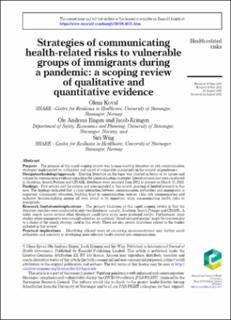| dc.contributor.author | Koval, Olena Mykolajivna | |
| dc.contributor.author | Engen, Ole Andreas Hegland | |
| dc.contributor.author | Kringen, Jacob | |
| dc.contributor.author | Wiig, Siri | |
| dc.date.accessioned | 2022-01-11T12:24:26Z | |
| dc.date.available | 2022-01-11T12:24:26Z | |
| dc.date.created | 2021-10-11T16:17:08Z | |
| dc.date.issued | 2021-10 | |
| dc.identifier.citation | Koval, O.M., Engen, O.A.H., Kringen, J., Wiig, S. (2021) Strategies of communicating health-related risks to vulnerable groups of immigrants during a pandemic: a scoping review of qualitative and quantitative evidence. International Journal of Health Governance | en_US |
| dc.identifier.issn | 2059-4631 | |
| dc.identifier.uri | https://hdl.handle.net/11250/2836902 | |
| dc.description.abstract | Purpose
The purpose of this rapid scoping review was to map existing literature on risk communication strategies implemented by authorities and aimed at vulnerable immigrants in the context of pandemics.
Design/methodology/approach
Existing literature on the topic was charted in terms of its nature and volume by summarizing evidence regarding the communication strategies. Literature searches were conducted in Academic Search Premier and CINAHL, databases were searched from 2011 to present on March 31, 2021.
Findings
Five articles met the criteria and were included in this review, pointing at limited research in this area. The findings indicated that a close interaction between communication authorities and immigrants is important. Community education, building trust in communication sources, clear risk communication and inclusive decision-making among all were found to be important when communicating health risks to immigrants.
Research limitations/implications
The primary limitation of this rapid scoping review is that the literature searches were conducted in only two databases, namely, Academic Search Premier and CINAHL. A wider search across several other databases could have given more profound results. Furthermore, some studies where immigrants were conceptualized as, for instance, “disadvantaged groups” might be overseen due to a choice of the search strategy used in this study. There are also certain limitations related to the studies included in this review.
Practical implications
Identifying efficient ways of conveying recommendations may further assist authorities and scientists in developing more effective health-related risk communication.
Originality/value
This study covered health-related risk communication in the context of pandemics, addressing the need to investigate different groups of immigrants and the challenges related to communicating risks to these groups. | en_US |
| dc.language.iso | eng | en_US |
| dc.publisher | Emerald Publishing Limited | en_US |
| dc.rights | Navngivelse 4.0 Internasjonal | * |
| dc.rights.uri | http://creativecommons.org/licenses/by/4.0/deed.no | * |
| dc.subject | kommunikasjon | en_US |
| dc.subject | pandemi | en_US |
| dc.subject | sårbare grupper | en_US |
| dc.subject | COVID-19 | en_US |
| dc.title | Strategies of communicating health-related risks to vulnerable groups of immigrants during a pandemic: a scoping review of qualitative and quantitative evidence | en_US |
| dc.type | Peer reviewed | en_US |
| dc.type | Journal article | en_US |
| dc.description.version | publishedVersion | en_US |
| dc.rights.holder | © 2021, Olena Koval, Ole Andreas Engen, Jacob Kringen and Siri Wiig | en_US |
| dc.subject.nsi | VDP::Medisinske Fag: 700::Helsefag: 800::Epidemiologi medisinsk og odontologisk statistikk: 803 | en_US |
| dc.source.journal | International Journal of Health Governance | en_US |
| dc.identifier.doi | 10.1108/IJHG-06-2021-0070 | |
| dc.identifier.cristin | 1944998 | |
| dc.relation.project | SHARE - Centre for Resilience in Healthcare: 5091 | en_US |
| cristin.ispublished | true | |
| cristin.fulltext | original | |
| cristin.qualitycode | 1 | |

